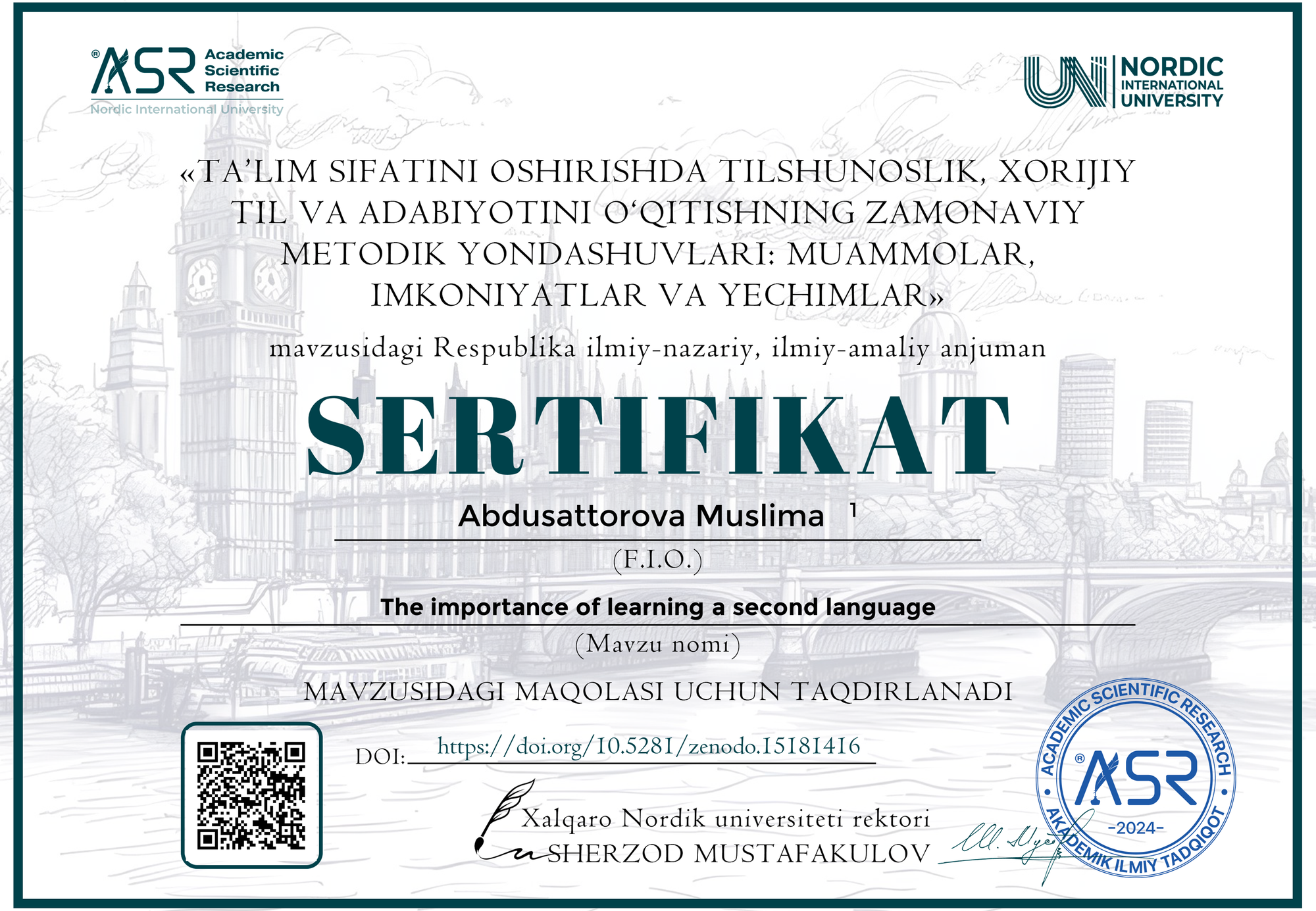Abdusattorova Muslima 1

DOI: https://doi.org/10.5281/zenodo.15181416
Google scholar: https://scholar.google.com/scholar?cluster=2439658145972615482&hl=ru&as_sdt=0,5
Zenodo community: https://zenodo.org/records/15181416
Nordic_press journal: https://research.nordicuniversity.org/index.php/nordic/article/view/2280
MAQOLANI YUKLAB OLISH
SERTIFIKATNI YUKLAB OLISH
REVIEW:
Abdusattorova Muslima’s article, "The Importance of Learning a Second Language," presents a comprehensive analysis of the many benefits associated with acquiring a second language, emphasizing its significance in education, personal development, and the global workforce. The author effectively addresses the cognitive, cultural, and professional advantages of learning another language, providing a clear argument for why language acquisition is crucial in today's interconnected world.
One of the article's notable strengths is its structured approach to exploring the various benefits of second language learning. The author first highlights the cognitive benefits, such as improved memory, problem-solving skills, and enhanced multitasking abilities. These cognitive advantages are well-supported by studies indicating that bilingual individuals tend to have better focus, creativity, and mental flexibility, which can be applied not only in academic settings but also in everyday life. The idea that learning a second language improves brain function, helps prevent memory issues, and enhances decision-making is a compelling and well-researched argument.
The article also makes a strong case for the practical advantages of bilingualism, especially in the context of career opportunities. Muslima argues that bilingual individuals have an edge in the job market, as many companies seek employees who can communicate across different cultures and languages. This is a well-acknowledged point, particularly as globalization continues to shape business practices. The inclusion of examples from various fields, such as international relations, tourism, and trade, strengthens the argument that bilingualism is not just an asset but often a requirement in many industries.
In addition to cognitive and professional benefits, the article emphasizes the importance of learning a second language in fostering cultural understanding. By learning another language, individuals are exposed to new perspectives, traditions, and ways of thinking, which in turn encourages greater empathy and open-mindedness. This is particularly relevant in today’s multicultural societies, where cross-cultural communication is essential for building relationships and fostering global cooperation.
Another strength of the article is its discussion of different motivational factors that drive individuals to learn a second language. The distinction between integrative and instrumental motivation, as explained by Gardner (1985), provides valuable insight into why some learners are more driven by personal and cultural connections, while others are motivated by career advancement or academic achievement. This nuanced perspective adds depth to the analysis and acknowledges the variety of factors influencing language acquisition.
However, the article could benefit from more specific examples of language learning strategies or case studies to illustrate the points made. While the discussion of cognitive and cultural benefits is well-supported, the section on teaching methods and language acquisition challenges could be further elaborated. For instance, the challenges of language immersion and overcoming learning barriers in different educational settings are briefly mentioned but not explored in detail. Including concrete examples of successful language programs or teaching techniques could provide a more practical angle to the discussion.
In conclusion, Abdusattorova Muslima’s article successfully highlights the multifaceted importance of learning a second language. The cognitive, professional, and cultural benefits of bilingualism are clearly articulated, making a compelling case for the value of language acquisition in the modern world. The article is well-researched and thoughtfully structured, offering valuable insights for educators, students, and professionals alike. While it could benefit from more specific examples and practical advice, it remains an insightful contribution to the discourse on language learning. The author effectively communicates why learning a second language is not only an academic pursuit but a life-enriching experience that opens up numerous opportunities in an increasingly interconnected world.



